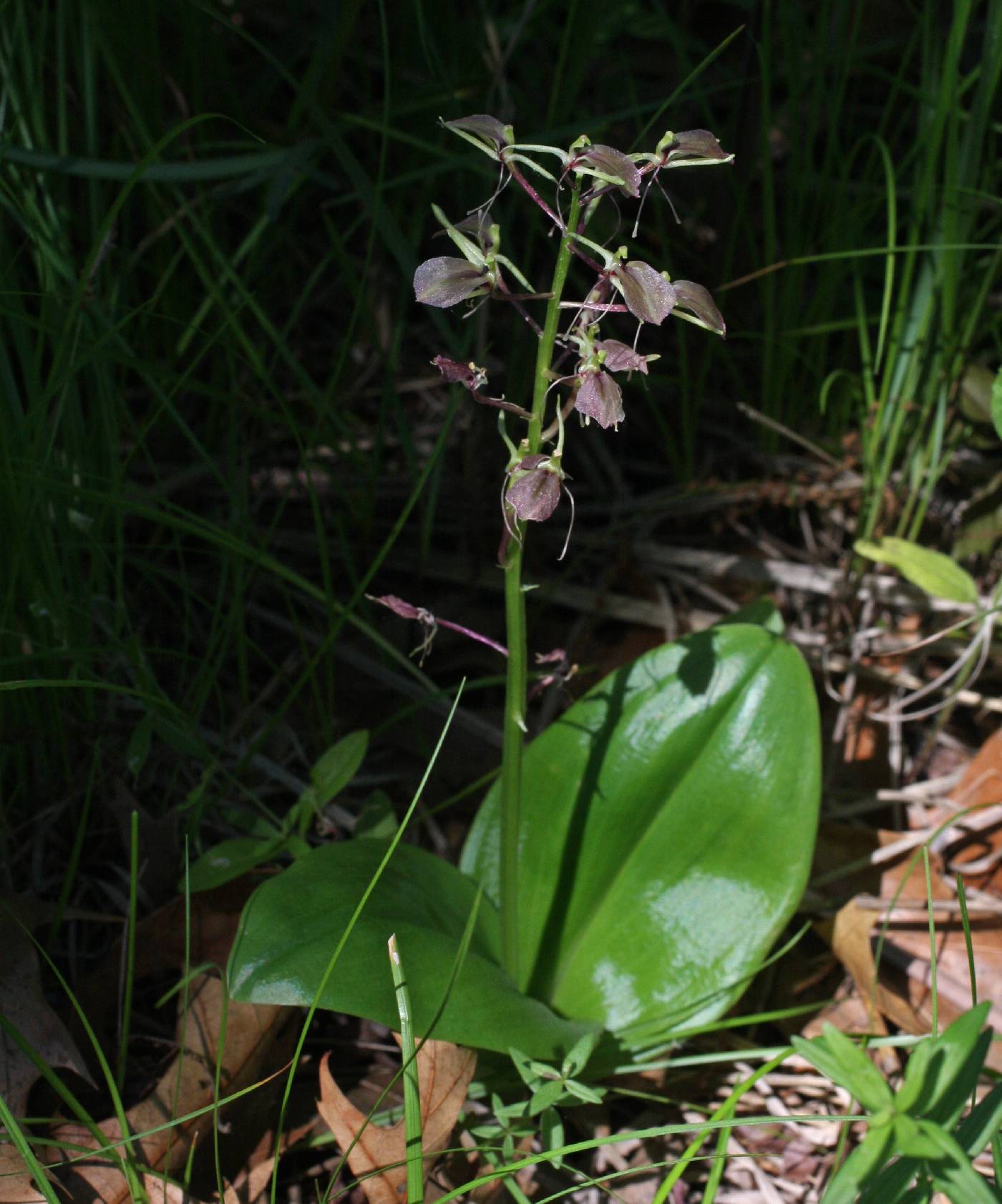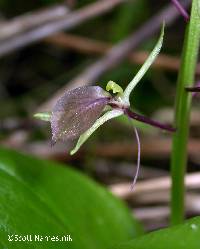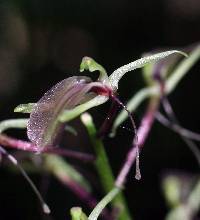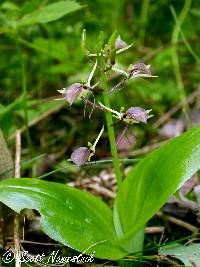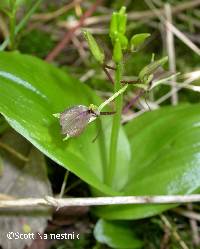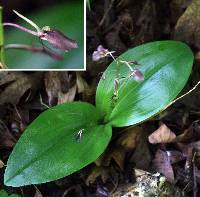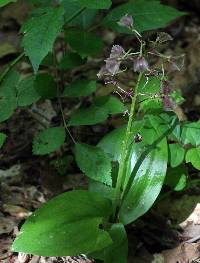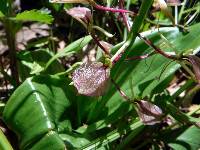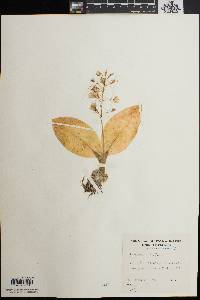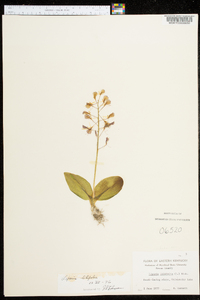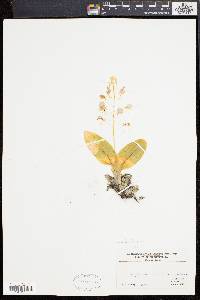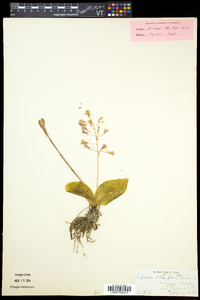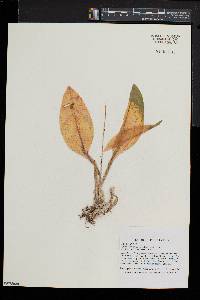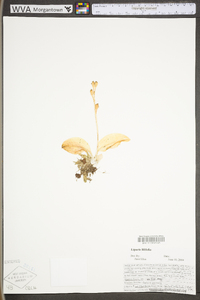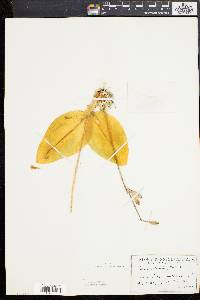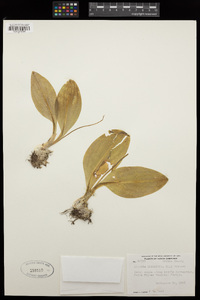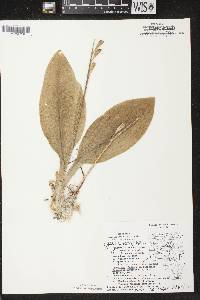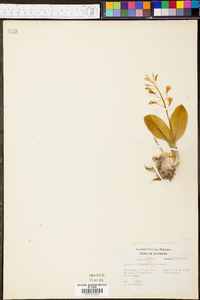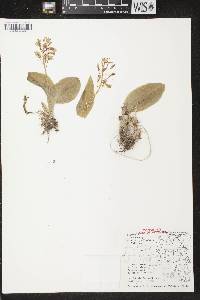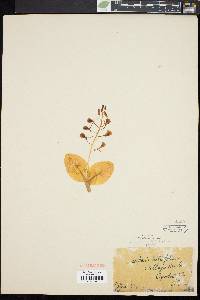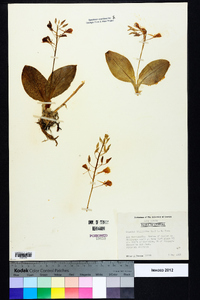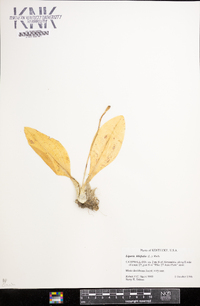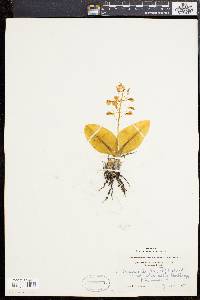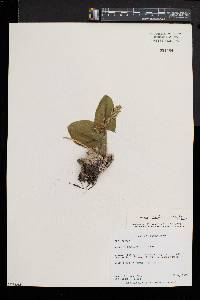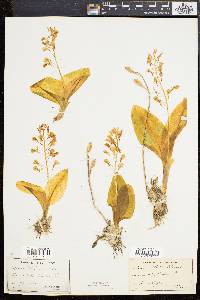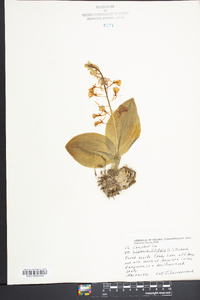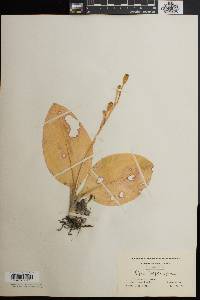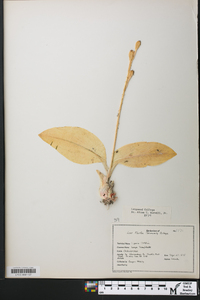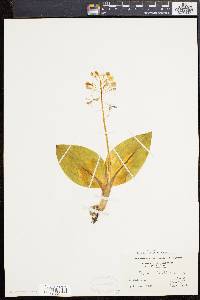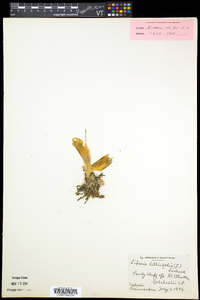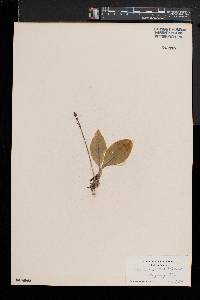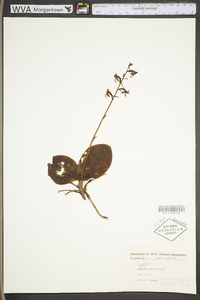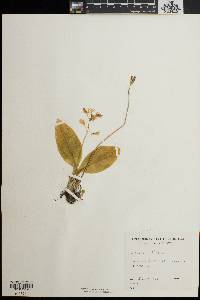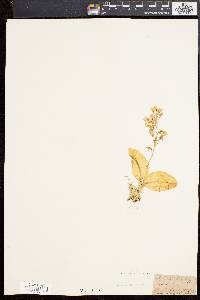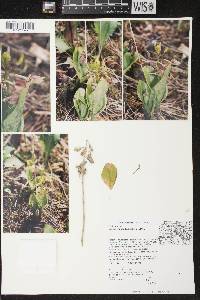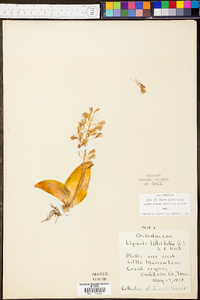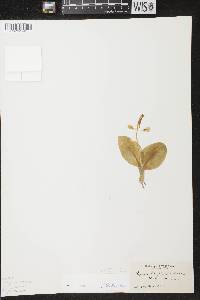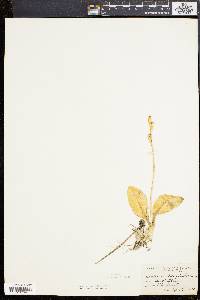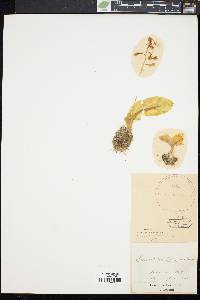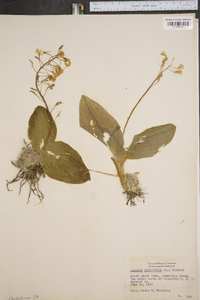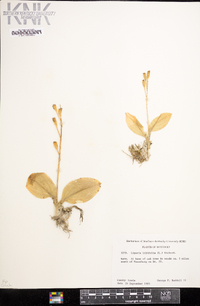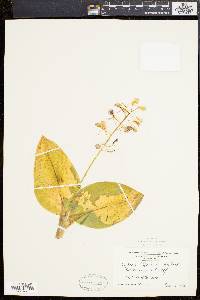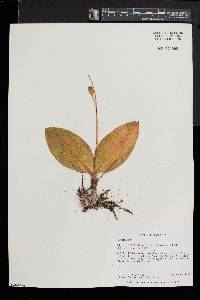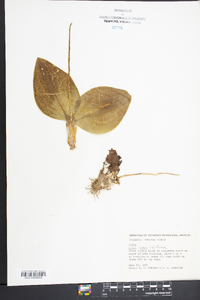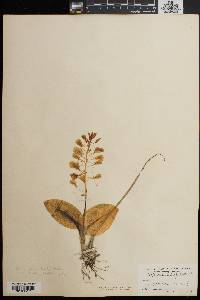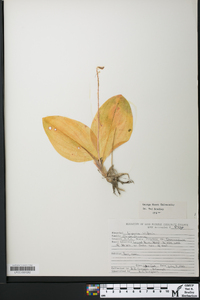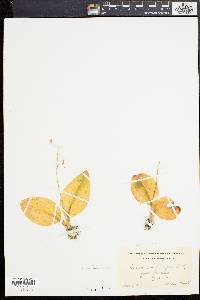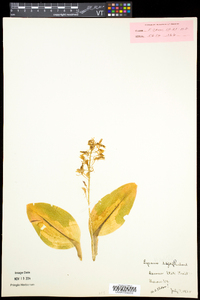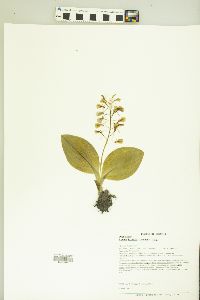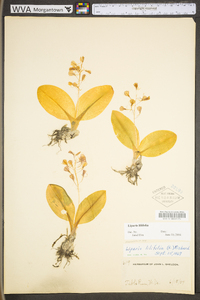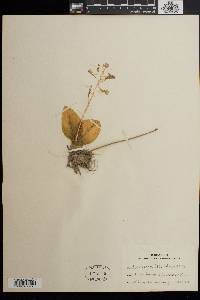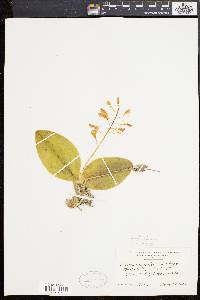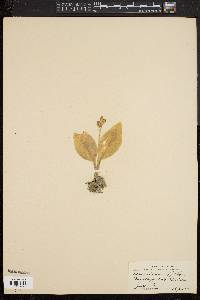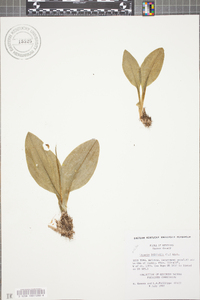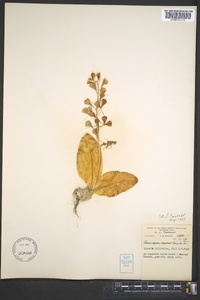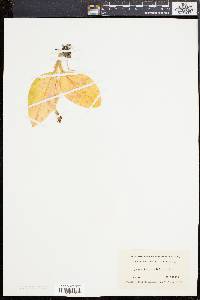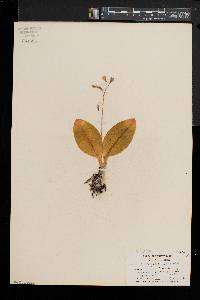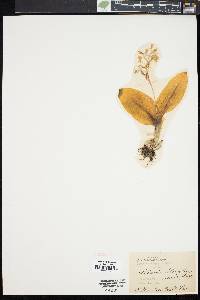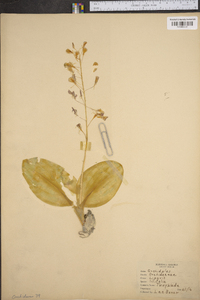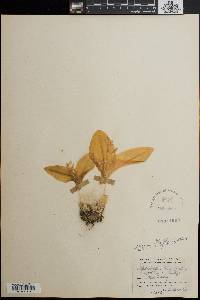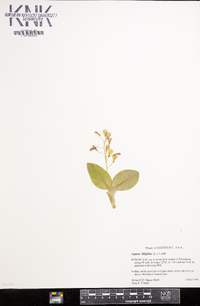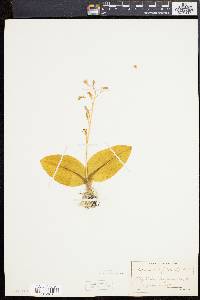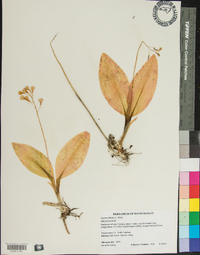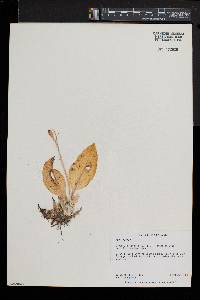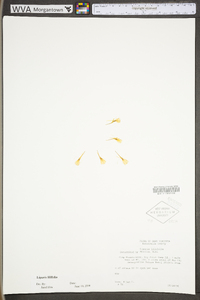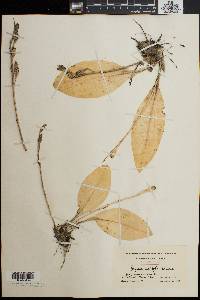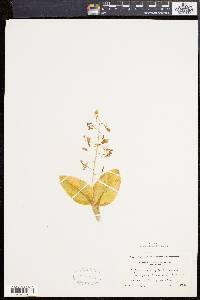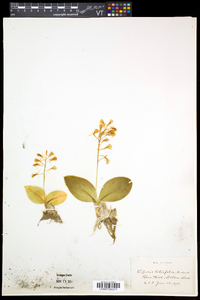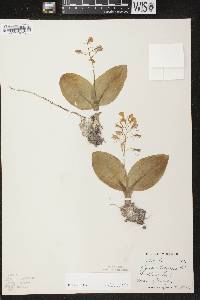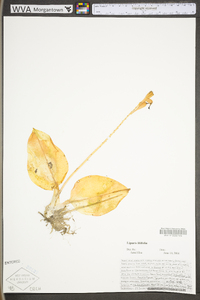Liparis liliifolia
|
|
|
|
Family: Orchidaceae
Brown Wide-Lip Orchid, more...large twayblade, lily-leaved twayblade
|
Plants 9-25 cm. Pseudobulbs ovoid, 20 ×10 mm, sheathed by bracts and persistent leaf bases, previous year´s pseudobulb usually present, connected by short rhizome. Stems bright green, with or without purplish brown tinge, angled, sometimes obscurely winged or fluted distally. Leaves 2; blade conduplicate, dark green, glossy, ovate-elliptic, keeled abaxially, 4-18 × 2-8.5 cm, succulent, apex obtuse to acute. Inflorescences 4-15 cm; floral bracts subulate, 2 × 1 mm, apex acute; pedicels slender, 5-7 mm. Flowers 5-31, mauve-purple and green; dorsal sepal oblong-lanceolate to narrowly lanceolate, 8-11.5 × 1.2-2 mm, apex obtuse to acute; lateral sepals oblong-lanceolate to narrowly lanceolate, 8-11.5 × 1.2-2 mm, apex obtuse to acute; petals pendent, curved, tubular, narrowly linear to filiform, 8.5-12 × 0.2-0.3 mm, margins strongly revolute; lip translucent, mauve to pale purple or rarely green with prominent purplish veining, cuneate-obovate to suborbiculate, 8-12 × 6-10 mm, base slightly auriculate, apical margin erose-serrulate, apex subtruncate, mucro-nate; column winged apically, 3-4 × 1-1.5 mm, with 2 blunt tubercles on inner surface near base; anthers yellow; pollinia yellow. Capsules: pedicel 11-18 mm; body ellipsoid, 15 × 5 mm, veins often slightly winged. Flowering May--Jul (north). Mature mesic to moist deciduous forests, pine woods, rich moist humus, often colonizing previously open, disturbed habitats during early and middle stages of reforestation; 10--1500 m; Ont.; Ala., Ark., Conn., Del., Ga., Ill., Ind., Iowa, Ky., Md., Mass., Minn., Miss., Mo., N.H., N.J., N.Y., N.C., Ohio, Okla., Pa., R.I., S.C., Tenn., Vt., Va., W.Va., Wis. Liparis liliifolia has what appear to be extremely similar relatives in Japan [L. japonica (Miquel) Maximowicz and L. makinoana Schlechter] and China (L. pauliana Handel-Mazzetti and L. cathcartii Hooker f.). Further work is needed to clarify the relationships among these five species. It could be a case of either divergent evolution from a common ancestor or convergent evolution from two or more ancestors.
Perennial herb 10 - 25 cm tall Stem: one, erect, bright green (sometimes with purple-brown tinge), angled, faintly winged, and hairless. Leaves: two (one in sterile plants), ascending-spreading, more or less basal, stalkless, strongly sheathing at base, light to dark green, glossy, shiny, non-toothed, hairless, sleek, fleshy, 4 - 18 cm long, 2 - 8.5 cm wide, egg-shaped to widely elliptic, ridged (keeled) along lower surface, partially folded lengthwise, and widely flaring at middle and toward rounded or blunt-pointed tip. Inflorescence: a single, erect, terminal, long-stalked (4 - 15 cm), elongate, loose, spike-like cluster of four to thirty slender-stalked flowers. Each slender, 5 - 7 mm long flower stalk is subtended by a single, minute (2 mm long, 1 mm wide), awl-shaped, pointed, hairless bract. Flowers: purplish and green, delicate, small (under 2 cm long), bilaterally symmetric, open (sepals and petals flaring), with lowest petal formed into a conspicuous lip, but lacking a spur. The reproductive parts of stamens, stigma and style are fused into a small, exposed column above the hairless inferior ovary. Sepals: three, widely spreading (lower two often hidden under lip petal), light green to pale brown or translucent, hairless, 0.8 - 1.2 cm long, 1 - 2 mm wide, narrowly lance-shaped with blunt or shallow-pointed tips, and rolled edges. Fruit: several, long-stalked (1.1 - 1.8 cm), erect, ellipsoid, 1.5 cm long, 5 mm wide, hairless capsules with remnant floral parts at tip, and slightly winged lengthwise veins. Root system: of a bulbous, egg-shaped, 2 cm long, 1 cm wide, fleshy pseudobulb at or upon substrate surface with a few fleshy, fibrous roots below, and sheathed at top by bracts and persistent leaf bases from previous season. Column: exposed, arching above lip petal, more or less yellow (anthers and pollinia yellow), 3 - 4 mm long, 1 - 1.5 mm wide, club-shaped, incurved, winged near tip, and with two blunt projections (tubercles) on inner surface near base. Lateral petals: two, downward pointing below lip, curved, purplish to brownish, 0.8 - 1.3 cm long, 0.2 - 0.5 mm wide, narrowly linear to threadlike, tubular with strongly rolled edges. Lip petal: one, lowermost, central, conspicuous, very wide, larger than sepals or lateral petals, translucent, purplish (fading to green with purple veins with age), 0.8 - 1.3 cm long, 0.6 - 1 cm wide, widest above middle. The lip is obviously inversely egg-shaped or almost circular, has two small ear-like appendages near the base, an abruptly rounded tip with irregularly-toothed edges, and a very small sharp point at the very center. Similar species: Liparis liliifolia is most similar to L. loeselii, but that species occurs in wetlands, has narrower more elliptic or lance-shaped leaves, shorter flower stalks and ovaries, green or yellowish green flowers, narrower and shorter lip petals (under 0.6 cm long, upto 3.5 cm wide), a shorter column (only 2 - 3 mm), and the fruiting stalks are shorter than the capsule length. A possible confusion could be made with Tipularia discolor, but that orchid flowers in the fall and at flowering time it has no leaves, also the flowers are much smaller (lip narrower and at most 0.8 cm long) and have long slender basal spurs. Another superficially similar species is Aplectrum hyemale, but that species is much taller (20 - 45 cm tall), and only has one basal leaf at flowering time, and this leaf is very dark green with obvious white veins and lengthwise pleats. Flowering: May to early July Habitat and ecology: Common for an orchid, an upland plant preferring sandy, well-drained, mildly acidic humus in mixed forests or thickets, but uncommon in areas with a dense canopy or in thick grasslike communities. This orchid is quite adaptive and is able to survive (and almost thrive) under certain disturbance regimes. Occurence in the Chicago region: native Notes: This is possibly our most common woodland orchid since it utilizes successional habitats. Though there are about 250 species in this genus worldwide, only three occur in North America. The closest relatives of L. liliifolia include four species in east Asia, and not the more northern North American species in our area, L. loeselii. In the genus the pseudobulbs are enclosed in the previous year's leaf bases and often also retain the dried stem. The pseudobulb of one year is connected by short rhizomes to a younger, daughter pseudobulb, which produces the current year's stem. The fleshy dormant pseudobulbs are often eaten by mice and voles. Etymology: Liparis is derived from the Greek word liparos for fat or greasy, and refers to the oily look and slick texture of the leaves. Liliifolia means lily-leaved, in reference to the similarity of the leaves to an old genus, Lilia, a group that included trout lilies (Erythronium) and lily-of-the-valley (Convallaria). Author: The Field Museum Scape 1-2.5 dm, with a loose raceme of 5-30 fls; lvs oval to elliptic, 5-15 נ2-6 cm; pedicels and slender ovary together ca 8-15 mm, widely spreading; sep greenish-white, 1 cm; lateral pet greenish to pale purple, 1 cm, projecting forward (or deflexed) under the lip and often crossed; lip pale purple, 1 cm, nearly as wide, rhomboid-obovate, subtruncate at apiculate summit, minutely erose, nearly flat; column 4 mm. Rich woods; Me. to Minn., s. to Ga. and Ark.; China. June, July. Gleason, Henry A. & Cronquist, Arthur J. 1991. Manual of vascular plants of northeastern United States and adjacent Canada. lxxv + 910 pp. ©The New York Botanical Garden. All rights reserved. Used by permission. From Flora of Indiana (1940) by Charles C. Deam Probably found in all parts of the state, being local in the northern part and more or less frequent in the southern part. The plant is very inconspicuous and doubtless it is more abundant than our records indicate. It evidently prefers a slightly acid soil and is generally found in deep humus in beech or white oak woods and more rarely in black and white oak woods. In Putnam County about 3 miles northwest of Greencastle, on June 3, 1910, I found it in a 19-year old Catalpa planting that had been first cultivated to strawberries and later abandoned. Here the plant was growing by the hundreds. In addition to the counties shown on the map it has been reported from these counties: Lake, Union, and Vigo. .…… Indiana Coefficient of Conservatism: C = 3 Wetland Indicator Status: FACU |
|
|
|

